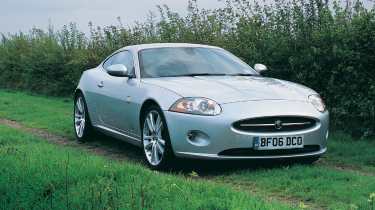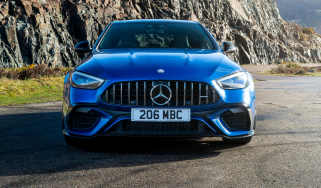Jaguar XK
The Jaguar XK has gone back, and Peter Tomalin reckons it will be a hard act to follow, despite some persistent electrical niggles
I saw a silver XK on the road the other day. It was a bit like seeing a ghost. Same spec as the recently departed BF06 DCO, same 20in alloys, but with a private plate, and it looked just fantastic. I used to stare out at the Jag when I was sitting here at my desk at home; today there’s just a space on the drive and it’s slowly dawning on me how tricky it’s going to be to fill it.
It would be difficult to overstate the importance of the XK to Jaguar, and we were intrigued to see if it could live up to the promise of the early launch drives. We chose Liquid Silver for our long-termer, apparently Ian Callum’s favourite colour for the XK, with charcoal leather and brushed aluminium trim on the inside. Apart from the 20in alloys (a £2500 extra), the rest of the spec was pretty much straight out of the box: 4.2-litre 294bhp V8 (essentially the familiar Jaguar V8 but with new engine management), ZF six-speed auto with wheel-mounted paddleshifters (a first for a Jaguar), and latest-generation CATS electronic adaptive damping and Dynamic Stability Control.
The day it was delivered to the office was a typically English, chill, grey, April Tuesday. I remember leaving my desk at regular intervals to peer out at it in the car park below – all tightly drawn lines and shades of Aston around the rear three-quarters. I took an early lunch that day.
First impressions were of a car with real substance, a feeling backed up by the weight of the driver’s door and the classy interior – all big, bold structures, not particularly sporty as such, but impressive nonetheless. Gone was the cosy, clubby old-school Jaguar ambience, replaced by something more confident, a modern take on the GT theme. I was particularly pleased to note that BF06 DCO already had 6645 miles on the clock – nicely run-in then.
It fired enthusiastically, with a really gruff V8 throb as I manoeuvred around the car park, and out on the road it felt instantly stiff of body and firm of suspension. Controls were well matched – steering and throttle lighter than in a Porsche, say, but positive, connected. The auto flicked uncannily smoothly between ratios, the ride felt muscular, taut – perfect for a sporting Jaguar coupe.
After that brief taster I couldn’t wait for the first drive home – the longest way I know. I’m lucky in this regard – whenever the A14 through Northamptonshire and Cambridgeshire is blocked (often), I have a back-road route that includes the excellent B645. Quite simply, the Jag blew me away that night. The faster I went, the better it got, the car slicing through corners at speeds you’d barely credit for a big Jaguar coupe, body control a revelation.
It was a performance it would repeat countless times in the coming months. The ride, as ever, was key to the Jaguar’s cross-country gait, but gone were the old, slightly floaty sensations. In fact just occasionally it would thump over really big bumps, but suspension and bodyshell felt all of a piece where the old XK would bobble and shimmy. Twelve months later, it still felt like a quality item.
Best of all was the gearbox. Regular auto mode did the wafting bit to perfection. Slide the shifter across the gate into Sport, and it would hold the revs that bit longer while delivering delicious throttle-blips on downshifts. The way it did this into corners and roundabouts was so eerily well-judged, you’d swear it could read your mind. And then there were the paddles, which delivered really crisp shifts with only occasionally the slightest jolt. A paddle-equipped conventional auto as good as this makes most automated manual boxes feel clunky and, frankly, pretty pointless.
The XK was properly quick, too. I’d wondered if the normally aspirated V8 would feel under-endowed, particularly after the arrival of the supercharged XKR, but somehow it never did. There wasn’t a huge amount of low-down torque, but once it was past 3500 it was as though the weight just fell away as it powered for the red line. There weren’t many quicker cars on the road. What’s more, it was incredibly efficient – a monthly average of around 24-25mpg was the norm; often we saw 26mpg-plus on longer runs. Once past about 10,000 miles it hardly seemed to use a drop of oil, either.
Just as well with the price of Mobil 1. Servicing costs weren’t outlandish – just two straightforward services in our time with the Jag, but at £242 and £252 they left you in no doubt this was a rich man’s car. The tyres, though, lasted remarkably well, the Dunlop SP Sport Maxxs serving for well over 20,000 miles before requiring replacement.
Dynamically, then, the XK is an unqualified success, and I can report that even after 12 months it never failed to engage me when I took to those back-roads. But what was it like to live with?
Initial impressions were mixed. The driving position took a bit of tailoring. Seat too high and my hair brushed the headlining; too low and the scuttle felt too high, the car too big and bulky. But when I’d finally hit on the optimum and programmed it into the memory, the XK proved as comfortable a long-distance cruiser as anything I’ve driven, though personally I’d have liked a slightly more figure-hugging seat. The touch screen that controls everything from satnav to climate control wasn’t intuitive but worked well after a few days’ familiarisation.
The rear seats were a real squeeze even for the two youngest members of the Tomalin clan, Freddie, 12, and Ben, 9. Anyone older could only fit by putting their backside in one seat and their legs in the other. Even with youngsters in the back, the front-seat passengers had to compromise their own legroom. The boot was reasonably accommodating, but you can’t fold the rear seatbacks flat, so it’s never going to carry more than one large suitcase and a squishy bag or two.
Irritatingly, there was no way of connecting an iPod – weird in a £60K Jag when much cheaper cars (including several Fords) have docking stations. The sound system with six-disc CD changer was good without being an audiophile’s dream, but the old-school radio aerial was cause of much amusement in the evo office. It was rather like the pole on the back of a dodgem car – you half expected to see a tattooed 20-year-old hanging off the back, ready to lean in and twirl the wheel if you got stuck.
As the months passed I was thoroughly enjoying being an XK owner, not least for the number of people who asked if it was the new Aston. Build quality seemed generally good. The only real bugbear was the slightly hit-and-miss sealing of the side-glass, which drops down when you open the door; if it didn’t resit properly, the wind tended to whistle around it at speed. By late summer the glass was occasionally not dropping at all, which meant you had to slam the door to get it to latch. The trim on the back of the passenger seat occasionally came adrift too.
But these things I could put down to this being an early example of a new model. More worrying were the electrical glitches. After my experiences with my previous Jaguar long-termer, the S-type R (evo 091), I’d been slightly apprehensive about the XK with its even more sophisticated electronics. The first hint that something might be amiss came when the screen started to flicker at night, then a couple of weeks later a warning flashed up in the main instrument binnacle for an indicator bulb failure. Apparently the front offside winker was on the blink (as it were). Then a few days later I pressed the starter button and the engine didn’t turn over. It took three attempts before it eventually fired. Hmm.
I booked the XK into Guy Salmon Jaguar in Northampton to have the bulb replaced and to run diagnostics on the electrical system, a 30-minute job. I returned in an hour to find they’d been unable to fix it. It wasn’t the bulb, apparently, which meant there had to be a problem with a wire somewhere, or with a control unit. This sounded ominously like my S-type experience. They would have to book the car in again, as they didn’t yet have the wiring diagrams. First available slot was a week later and no courtesy cars were available. Not great.
A few days later, driving home at night, I was being flashed by oncoming cars, and then I noticed the XK’s reflection in a shop window – the offside headlight was also out. The car seemed to have had a mild stroke affecting one side. I was not chuffed, driving a car that was potentially dangerous and probably illegal. Eventually it went back to Guy Salmon, who called mid-afternoon to say they’d found the problem – an earth strap had come adrift inside the front wheelarch (more déjà vu after the S-type experience of a chafed wire). It would need to be refixed with a stud, which required a special tool, which would mean the car having to go back to Castle Brom. It was back by teatime the next day.
Everything seemed OK for a while, except that a couple of weeks later the engine failed to turn over on the button again. This would prove to be an occasional irritant for the remainder of the time we had the car. We tried a spare keyfob, in case that was the problem, but no joy. More successfully, at the suggestion of a fellow XK driver who had suffered the same problem, we tried ignoring the handbook and pressing the starter button before depressing the brake pedal. Most times that did the trick. I asked Guy Salmon to take another look at the 20,000-mile service, but they couldn’t reproduce the fault so couldn’t fix it, though the fact that I had to complete a Jaguar questionnaire describing the exact symptoms suggested the problem wasn’t unknown to the car maker.
But none of these irritations prevented me from enjoying the XK. All you had to do was seek out a half decent road, select Sport and really drive it. The more serious you were with it, the more it seemed to stiffen its sinews. The 20in wheels proved a good choice, giving a really broad-shouldered feel to the handling, while the brakes were well up to the performance and weight (the XK is not quite as light as Jaguar would have you believe – our scales revealed a fairly portly 1721kg despite the largely aluminium bodywork). The headlights, however, weren’t quite up to the performance, being distinctly ordinary on full beam; the gimmick of the optional Intelligent Lighting System that ‘sees round corners’ didn’t entirely compensate.
In our early drives of the XK we wrote that Jaguar hadn’t forgotten how to make a sports car. That may well still prove to be the case, but I don’t think the XK is quite that car, not even in supercharged XKR form. The steering and chassis are still more sporting GT than outright sports car, and the engine note’s just a touch muted from inside at speed. But this XK is a sportier Jaguar, for sure, and as a GT it engages us and involves us like few others. All the software for the adaptive dampers, the speed-variable power assistance, the three-stage DSC, the ‘intelligent’ auto – in the same way that Porsche renders these things practically invisible, so Jaguar has learned the same trick.
My colleagues were always keen to give me a break from the XK, and all of them loved it, none more than editorial director Metcalfe, who often gravitated towards it when a long journey loomed, the last of which was to Geneva. That journey ended rather ignominiously, the XK limping home on its space-saver after an earlier ding to one of the front wheel rims eventually caused the tyre to deflate rapidly on the homeward journey. Still, it did contribute to an all-time XK economy record of 27.6mpg! And so, on March 12, the Jaguar departed with a lurid red space-saver on the front offside. It still looked, well... gorgeous. And despite its problems, we’ll miss it terribly.
Running Costs
| Date acquired | April 2006 |
| Total mileage | 21,871 |
| Duration of test | 12 months |
| Average MPG | 24.9mpg |
| Servicing costs | £495.24 |
| Consumables | £960 (tyres) |
| Price new | £63,400 (incl options) |
| Trade in value | £51,500 |
| Depreciation | £11,900 |



